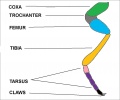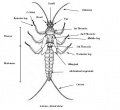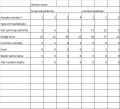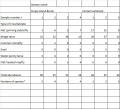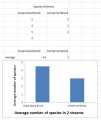Aquatic insects: playful biology teaching
| Students @ Work - a student collaborative writing project. Help us by providing feedback on the Discussion page. |
| Instant wiki maker | Making handouts | Editing tips |
Biology In Elementary Schools is a Saint Michael's College student project from a course that ran between 2007 and 2010 and fully described in this book chapter. The student-created resources have been preserved here for posterity. Link under 'toolbox' for printer-friendly versions of the exercises. Click on handouts to print full resolution versions. Please see Wikieducator's disclaimer, our safety statement, and the Creative Commons licensing in English and in legalese.
Student worthiness
Brand new and untested
Primary biological content area covered
This acitivy will give to students a background about aquatics insects in a classroom and hands on experience during the field trip, giving them a fun approach to knowledge.
Materials
- Field Trip Kit
- Rain boots
- First aid kit
- Kick net
- Kitty litter tray
- Ethanol (rubbing alcohol is a good substitute)
- Field forceps (inexpensive eyebrow tweesers work well)
- Plastic spoons
- Whirlpacks (ziploc bags also work)
-Classroom
- Stuffed animals( mayfly, caddysfly and stonefly).
Handouts
Students will each be given one handout on which they will fill out insects body parts ( anatomy) of mayfly, stonefly, and/or caddisfly. Also, the insects life cycle.
- Printable handouts for lab portion of activity.
Description of activity
This activity happens in two parts: A field trip to collect insects; and classroom time to examine what was collected. If they happen in the same day then the activity can be done using live insects and no ethanol is needed.
The field trip activity stimulates student curiosity because they tend to be amazed at the creatures that live in stream environments. Because they see amazing insects that they would not ordinarily experience, they are usually very excited to be learning about them. Because this is a wet field activity it is good to give students and parents advanced notice so that children will come dressed appropriately for field trip day. During the field trip, students will collect samples that can later be analyzed in the classroom.
Lesson plan
- During the field trip day, the students, teacher, and adult volunteers will go to an specific site they will be divided into groups of 5 or 6 with an adult helper so they can learn about the sampling process in a hands-on fashion and can explore and ask questions during their collecting process.
- AT first, the teacher can briefly demonstrate how to collect a sample using a kick net.
- It is worth quickly demonstrating the entire process from net preserving the sample in the wirlpacks with the label inside and ethanol.
- Next it is time for the students to practice what was learned from the teacher and each group should repeat the procedure one or two times.
- In the classroom, the professor will ask the student what they already know about insects parts and life cycle, a kind of brainstorm , so he can know the students previous background.
- After, the professor will give a whole background about insects anatomy and their life cycle.
- If available, the professor will show the ,mayfly, caddysfly or stonefly stuffed animal and make the relation between the parts we can clearly see from the animal e that show also in the stuffed animal.
- Handouts will be given to students so they can practice insects body parts ( anatomy) they learned previously
- A life cycle handout will be given too, so that they will understand more from visualization and memorization.
Potential pitfalls
- Bad weather - Solution : Change date
- No van avaluable - Solution - Change date
- Difficult to find insects after a storm - Solution : Use the samples previously collected.
Math connections
This activity can easily be tailored to any age from the youngest grades through to science fair projects and even college. We have presented below a number of options with increasing layers of complexity. It is up to the teacher to take the content to the level that best matches the audience.
- Counting the number of insects found.
- Count the number of different types of invertebrates found. Ecologists call this species richness or taxon richness
- Taking replicate samples.
- Calculate averages from the samples taken
- Compare two or more streams; perhaps a forested stream and an urban stream
- Make bar graphs.
- Printable data sheet and examples of one way to produce graphs for a science fair project.
Connections to educational standards
Educational standards in the biological sciences that this activity could address include life cycles, biodiversity, ecosystems, and human impacts on natural systems. We invite teachers in different localities to contribute specific connections to their local standards here.
Next steps
- Students can further learn how to identify the major orders of insects and also elaborate and present a group work explaining each order and family and it characteristics.
Reflections
This project is a new and an untested project ; however, it has in essence the ability to make the students having fun while learning about one subject, in this case, about aquatic insects. Is designed to attract the student by curiosity and throw hands on experience when the students are in the field trip and also, in the classroom once they will have not only a background about insects but also playful knowledge at school.
Citations and links
- Eisner, T. (2003). For love of insects (p. 448). Cambridge, Mass.: Belknap Press of Harvard University Press.
- Cranshaw, W., & Redak, R. (2013). Bugs rule!: An introduction to the world of insects (p. 480). Princeton University Press,Princeton,New Jersey.
Common mistakes
- Do not enter in deep water;
- Use the rain boots or waders so you do not get wet;
- Do not forget to use ethanol right after collecting the insect so they do not dry out;
- Do not forget to use labels so you will remember in which site the insects were collected.

